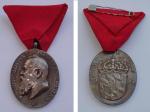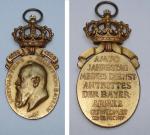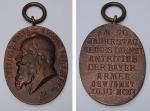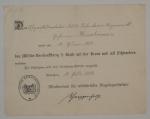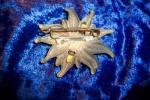-
Posts
57 -
Joined
-
Last visited
Content Type
Profiles
Forums
Blogs
Gallery
Events
Store
Everything posted by Bavaria
-
The last type came in 1911 because of the 90th birthday of the Prinzregent. It looks like the 1909-type, just showing the years “1821 – 1911”. It was made from bronze. There are 2 types: - Bronze - Gilded Each had just around 30 awards to especially officers with tight connections to the 1. FAR or to the Prinzregent.
-
In 1909 the crown was established. The reason was the 70th aniversity of becoming Colonel in Chief. This “new class” was especially for officers and NCOs of 1. Feldartillerieregiment (the Prinzregent´s regiment), also for veterans of 1. FAR from 1866 and 1870/71. Owner of the Juliläumsmedaille (type of 1905) had to put the older one away and wear just the new crown-type. The same ribbon from 1905 was used. There were 2 variations: - Breast decoration: gilded; around 2000 awards - Neck decoration: golden; just around 5 or 6 awards (e.g. Bavarian war minister). The picture shows one of the gilded medals.
-
Hello Dave I want to add some informations to your post. We have to differ between 3 types of the Jubiläumsmedaille and 2 types of the Prinzregent Luitpoldmedaille: The first type of the Jubiläumsmedaille was created on 12.03 1905. Dave´s information concerning the circumstances are correct. Here a picture of this type. There was just one class of this type.
-
Hello Claudio Thank you for showing. Your MVK 3. Kl with crown and swords is very rare. It´s the last type of Deschler. This type has an one-piece cross (no separate fixed medaillons) and is made out of zinc (Kriegsmetall). Be aware, that there are a lot of falsified MVK3kr x (former copper/bronze cross with gray/zinc coating). Original pieces have a very specific fixing of the iron swords. Kind regards Rudi
-
Hello Eric Your first cross is a Leser (like already mentioned), but it´s form the last type. So it´s definitely no 2nd model (1905-1913). It was just silver-plated. The second one (with enameled centre) is the same late type, so I have to entitle avardski`s opinion. Your 2nd class with crown and without swords looks interesting. It´s the first type of Leser´s crosses (after 1913). Genuine pieces without swords are very rare, I´ve seen just a very little amount of them over the years (maker: Hemmerle), but there might be also original pieces in this 1st Leser´s type without swords. But: I´ve also seen a lot of these early pieces with removed swords (this first type is very, very rare, so shame on this fakers). Can you post a larger picture of (especially) the upper arm of the cross to have a closer examination? Kind regards Rudi
-
One of the last type is signed by Oberstleutnant von Bressensdorf, who was responisble for the Heeresabwicklungsamt Bayern (Office of Army transaction Bavaria). This type is followed by one last one. It has a seal of the Bavarian Ministry of Forreign Affairs. I´ve seen one of this type, but I haven`t (yet) one in my collection. Kind regards Rudi
-
The second type is signed by General Philipp von Hellingrath. He became bavarian war minister in December 1916, when v. Kress`s successor v. Speidel left this position. Until now, I haven`t seen a document signed by v. Speidel. This document is for an "Beamter", so there is the addition "am Bande für Kriegsverdienst"




